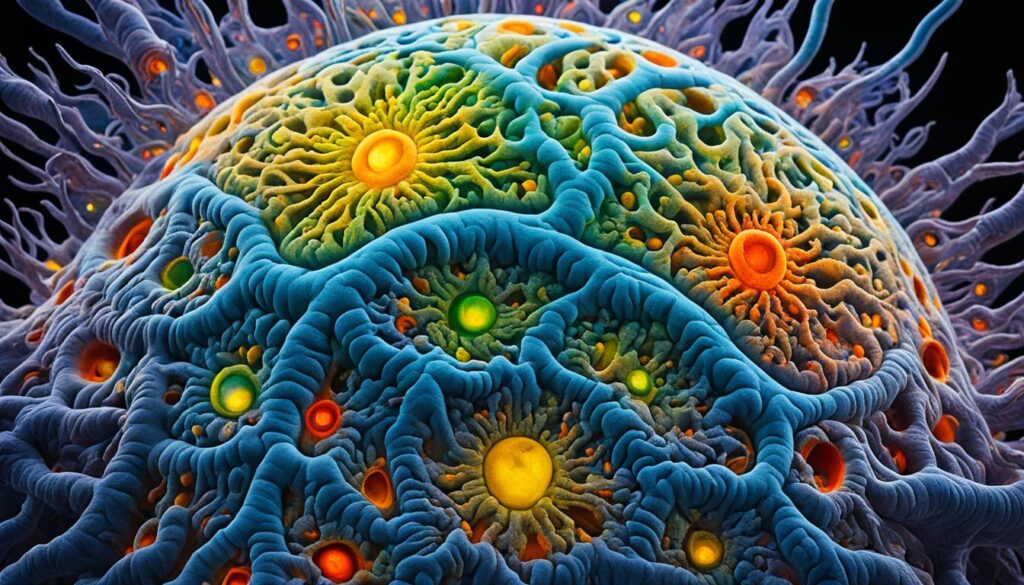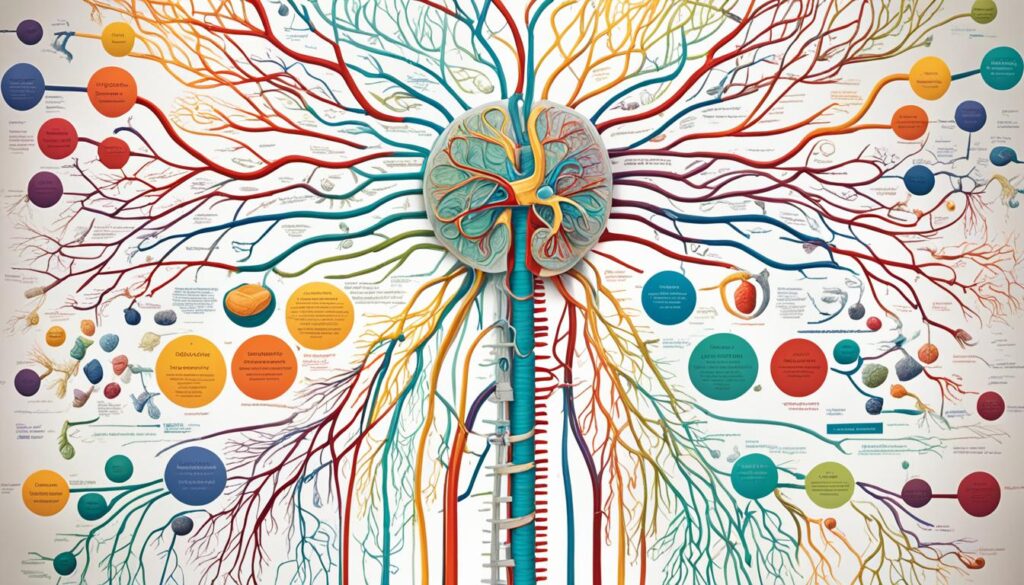Explore the fascinating world of human emotions with us. We’ll dive into the latest in neuroscience, psychology, and technology. This journey will help us understand how our brains work and affect our feelings.
Learn about the amygdala’s role in fear and anxiety. Discover how the prefrontal cortex helps control our emotions. This guide will explain the brain’s role in our feelings.
See how neurotransmitters like dopamine make us feel pleasure. Find out how our bodies react to emotions through the autonomic nervous system.
Discover how emotions and thinking are connected. Learn about emotional intelligence and how to improve it. Explore how culture affects how we show emotions and the effects of bad emotional control on mental health.
If you’re curious about your feelings or want to know more about the human mind, this article is for you. Get ready for a journey into the science of human emotions.
The Intriguing World of Emotions
Emotions are key to our human experience. They shape how we see things, make decisions, and feel overall. Let’s dive into the world of emotions to see what makes them so complex and how they connect with our thinking.
Understanding the Essence of Emotions
Emotions are more than just feelings. They mix physical, behavioral, and mental parts together. They come from how we see events or people, and they deeply affect our thoughts and actions. Emotions guide us through life, from excitement to sadness.
The Interplay of Emotions and Cognition
How emotions and thinking work together is really interesting in psychology. Emotions and thoughts are closely linked. They shape how we see and react to the world. Researchers study how our feelings influence our thoughts and decisions.
As we keep looking into emotions, we’ll see how complex and important they are. Understanding emotions and their link to our thinking helps us see more about being human. It shows us how to deal with life’s challenges.
Technology: Exploring the Neural Underpinnings
We’re on a journey to explore how technology and emotions connect. Advances in neuroscience, brain-computer interfaces, and emotional AI are revealing how our brains work with our feelings. These areas are showing us the complex ways our brains affect our emotions.
Technology and neuroscience together are giving us new ways to understand our feelings. Researchers use brain-computer interfaces to see how our brains and emotions work together. This helps us learn more about the emotional brain.
Emotional AI is where technology and feelings meet in a new way. It uses machine learning and AI to understand and even mimic human emotions. This field could change how we use technology, making it more sensitive to our feelings.
Looking into technology and the neuroscience of emotions shows us big possibilities. It could improve mental health treatments and make technology more aware of our feelings. This connection could help us understand ourselves and our emotions better.
The Amygdala: The Emotional Command Center
The amygdala is a small almond-shaped part of our brain. It’s key in shaping our emotional experiences, especially fear and anxiety. By learning about the amygdala, we can understand how our brain handles these strong feelings.
Unraveling the Amygdala’s Role in Fear and Anxiety
The amygdala is called the “emotional command center.” It quickly sorts through sensory info and starts the right emotional response. If our brain sees a threat, the amygdala kicks in, making us ready to fight or run away. This fast action helps us react quickly to dangers, keeping us safe.
But the amygdala does more than just react to fear. It also affects anxiety, a lasting and often tough emotional state. Studies show that people with more active amygdalas tend to feel more anxious. This is because the amygdala gets too sensitive to threats, real or not.
The amygdala doesn’t just deal with negative feelings. It’s also part of processing positive emotions like joy and rewards. Knowing how the amygdala works helps us see how our emotions, thoughts, and overall health are connected.

The Prefrontal Cortex: Regulating Emotions
The prefrontal cortex is at the front of the brain. It’s key for managing emotions, which is important for feeling good and staying well. This area helps us think deeply and control our feelings.
It works with other brain parts like the amygdala to handle our emotions. The prefrontal cortex helps us think before we act, stopping us from doing things on impulse. This balance is key for staying emotionally stable and smart about feelings.
Studies show that people who can manage their feelings well do better in life. They handle stress better, make smarter choices, and have healthier relationships. But, if the prefrontal cortex isn’t working right, people might face problems like anxiety, depression, or acting without thinking.
Learning about the prefrontal cortex and emotions helps us understand how our brains work. This knowledge can lead to better ways to handle feelings. It can improve our mental health and make our lives better overall.
The Neurotransmitter Dance
Human emotions are like a complex dance, led by neurotransmitters. These chemicals help our brain cells talk to each other. Dopamine is a key player, affecting how we feel pleasure, get rewards, and process emotions.
Dopamine: The Messenger of Pleasure and Reward
Dopamine is called the “feel-good” neurotransmitter. It plays a big role in our motivation, choices, and happiness. When we do things we enjoy, like reaching a goal or having fun, dopamine is released.
This release makes us feel good and want to do those things again. It’s important for our happiness and satisfaction. By knowing how dopamine works, we can understand our feelings better.
Neurotransmitters like dopamine are key to our emotional world. They create a mix of feelings and memories that shape who we are. Exploring this world shows us how our brain affects our life and helps us find pleasure and rewards.
The Autonomic Nervous System: Orchestrating Physiological Responses
The autonomic nervous system connects emotion and physiology deeply. It’s a complex network that controls our involuntary actions. It makes our body react to our feelings.
This system has two main parts: the sympathetic and parasympathetic nervous systems. The sympathetic system gets us ready to act fast when we’re stressed or scared. It makes our heart beat faster, muscles tighter, and breathing quicker.

On the other hand, the parasympathetic system helps us relax and digest food. It slows down our heart, helps with digestion, and saves energy. This balance keeps our body’s responses right for the situation.
When we feel an emotion like fear or happiness, our autonomic nervous system reacts. It changes our body to get ready to act. The fight or flight response is key in showing how we feel physically, like getting butterflies or blushing.
Learning about the autonomic nervous system helps us understand how our emotions affect our body. It shows the deep connection between our feelings and physical reactions.
Emotional Intelligence: Navigating Life’s Complexities
Emotional intelligence helps us understand and manage our feelings. It’s key for dealing with life’s ups and downs. By being aware of our emotions and learning to control them, we improve our mental health and relationships.
Developing Emotional Awareness
Being aware of our emotions is the first step in emotional intelligence. It means noticing how we feel, figuring out why, and seeing how they affect us. This helps us handle our feelings better and make smarter choices when things get tough.
Strategies for Emotion Regulation
Managing our emotions is about controlling how we feel. Good strategies help us deal with stress, solve problems, and keep relationships strong. Techniques like changing how we think, practicing mindfulness, and solving problems actively can help us stay in control of our feelings.
With emotional intelligence, we can face life’s challenges with more awareness, understanding, and strength. Taking care of our emotional health not only helps us but also makes our relationships better. This leads to happier and more meaningful lives.
Cultural Influences on Emotional Expression
Emotions are deeply tied to the culture we live in. They are shaped by the social norms, beliefs, and values of our society. This shows how culture affects how we feel and show feelings.
What emotions we can show varies across cultures. In some places, showing strong feelings in public is seen as weak. But in other places, it’s seen as a way to grow and understand oneself.
These differences in how we show feelings can lead to misunderstandings. When people from different cultures meet, they might not get each other’s feelings right. It’s important to be sensitive to these differences to understand each other better.
Learning about how culture affects our feelings helps us see the world in a new way. It teaches us to value the different ways people feel and express emotions. This can help us communicate better with people from other cultures.
Emotions and Mental Health
Our emotions deeply connect with our mental health, playing a key role in our overall well-being. Struggling to control our feelings, known as emotional dysregulation, can really affect our mental state. It can lead to various mental health issues.
The Impact of Emotional Dysregulation
Not being able to handle our emotions can cause mental health problems like anxiety, depression, and mood disorders. People with emotional dysregulation may find it hard to deal with stress, control their actions, and keep healthy relationships. This can make mental health issues worse, creating a tough cycle to escape without help.
It’s important to tackle emotional challenges as part of a full mental health plan. By becoming more aware of our emotions, learning how to manage them, and getting help when we need it, we can improve our mental health. This way, we can better handle life’s ups and downs with more strength and flexibility.






